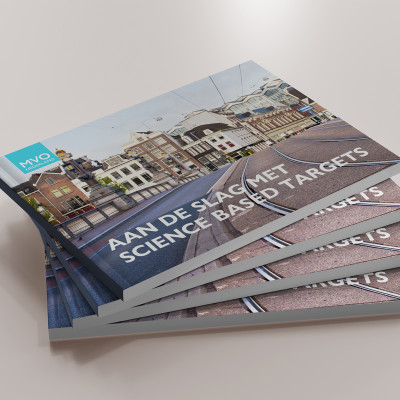Getting started with Science Based Targets
Stappenplan
For partners

For partners
Climate change and global warming require swift and decisive action, including from business. Many entrepreneurs in the Netherlands are therefore reducing greenhouse gas emissions. In doing so, society naturally expects more from large, polluting companies than from small ones. They switch to electric cars, insulate their office buildings, exchange heat with nearby companies or invest in green electricity. These are all good actions, but how do you know if it is enough? Science-based targets (SBT) offer the answer. In this article, you will read what exactly they are and why they are important.
Scientifically based goals
Science Based Targets (SBT) are science-based targets that provide a thorough analysis of your emissions and reduction plans. By working with these targets, you will know whether your targets, in proportion to the nature and size of your business, are sufficient to meet the Paris Climate Agreement. There it was agreed that we must limit global warming to well below 2 degrees, and if possible even to a maximum of 1.5 degrees.
The gold standard
The big advantage of working with Science Based Targets is that you know for sure that your climate efforts are sufficient; it is not for nothing that SBTs are considered the 'gold standard'. They put an end to long-running discussions about the level of ambition of energy and climate targets. And then you can focus on the core: reducing emissions. So it makes sense that companies serious about climate change are increasingly adopting Science Based Targets.
Science-based targets and the carbon budget
Starting from a maximum warming of 2 degrees, scientists can calculate to what level the CO2 content in the atmosphere is still allowed to rise. This produces the 'carbon budget': the number of tonnes of greenhouse gases emitted before climate change derails irrevocably. If nothing changes, this budget will be used up within a few years. This is the reason why not only do emissions have to go to zero in the long term, but also why it is important to reduce emissions now, soon. After all, the sooner you start cutting CO2 emissions, the longer we have before the carbon budget is used up.
To distribute the carbon budget fairly, it is divided into targets per country (called Nationally Determined Contributions, NDCs) and per sector. Thus, for all organisations, with some calculation, it is possible to deduce what their share of the carbon budget is. In this way, you can also determine the Science Based Targets for your own company. In other words, if you commit to the SBTs, you take your fair share to meet the Paris Climate Agreement commitments. If all companies met these targets, global warming would be limited to 1.5 degrees. You can of course do more, but if your targets are less ambitious than the SBTs indicate, you are contributing too much to climate change.
Once you have set your targets, you can submit them to the Science Based Targets initiative (SBTi), an organisation that ensures that the right approach has been followed. If you meet all the requirements, your targets will be officially approved by the SBTi. With that, there is no doubt that you are doing what is expected of you in the area of climate. Then, of course, you must do everything possible to achieve the targets.
Getting started with Science Based Targets
Do you also want to get started with Science Based Targets, but don't yet know how? We developed a 'Getting started with Science Based Targets' that will take you by the hand in making a concrete plan for this exercise. Fill in the form below and you will soon receive the link in the mail.
